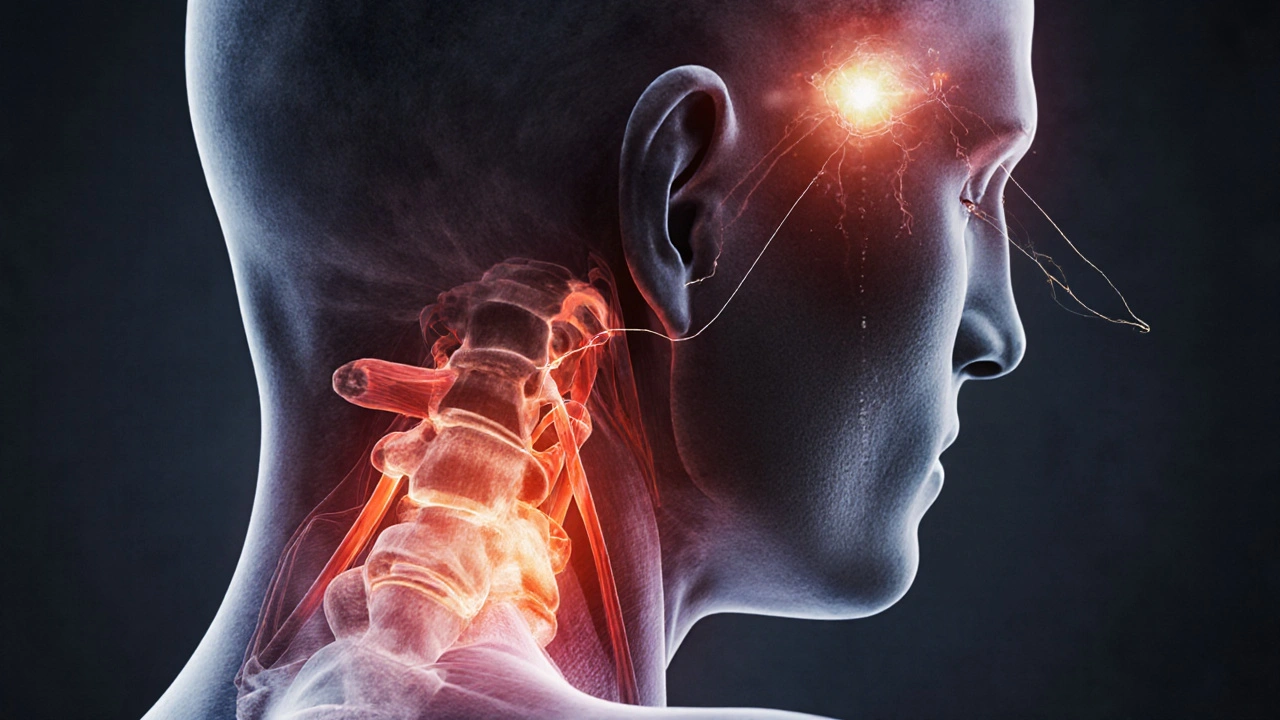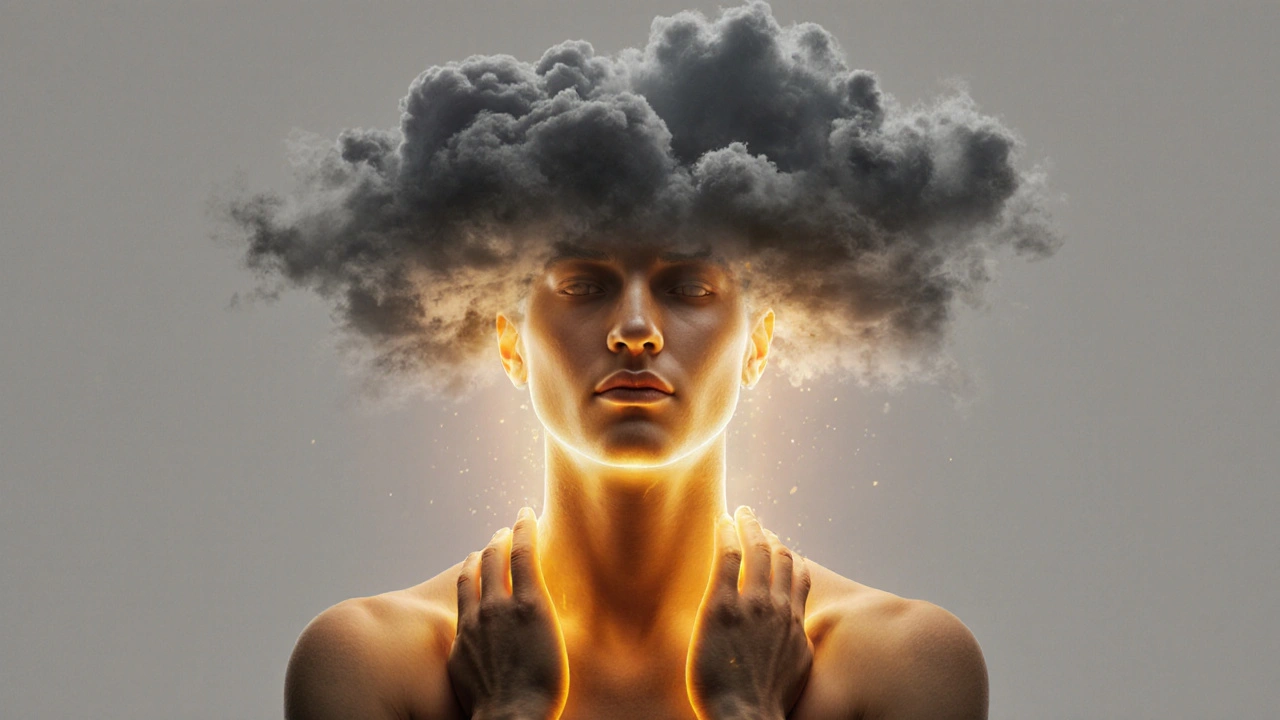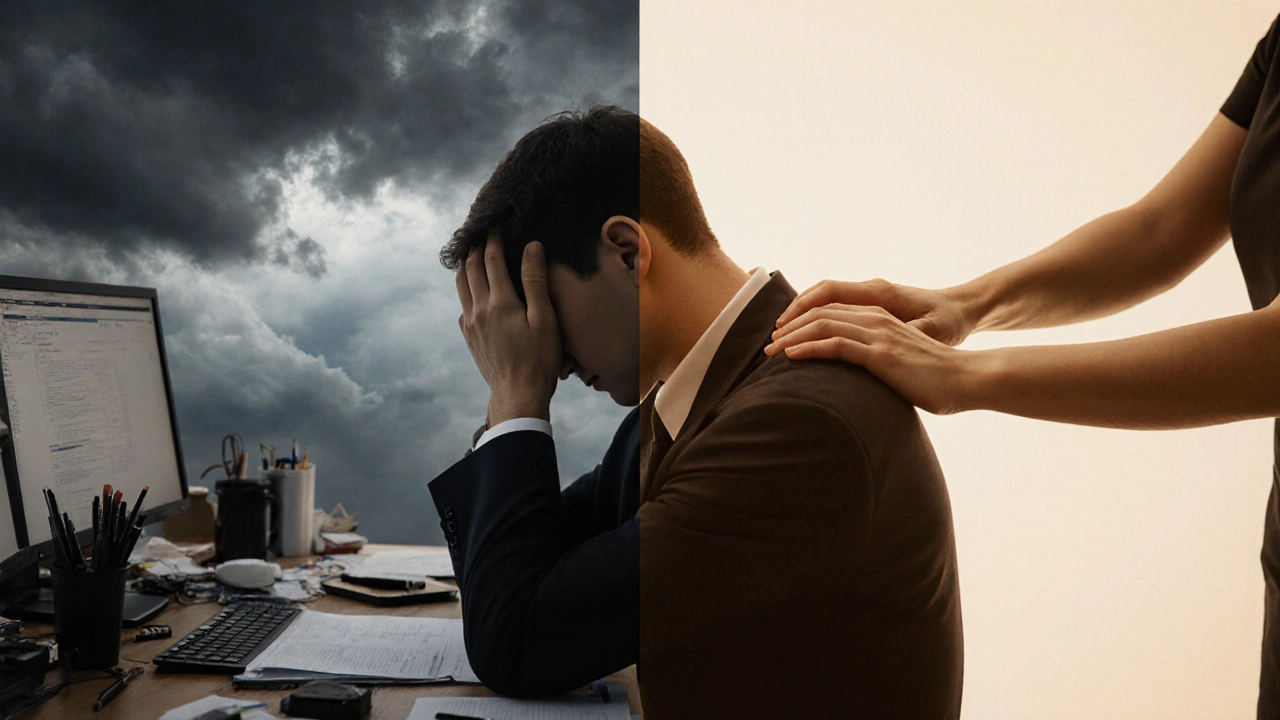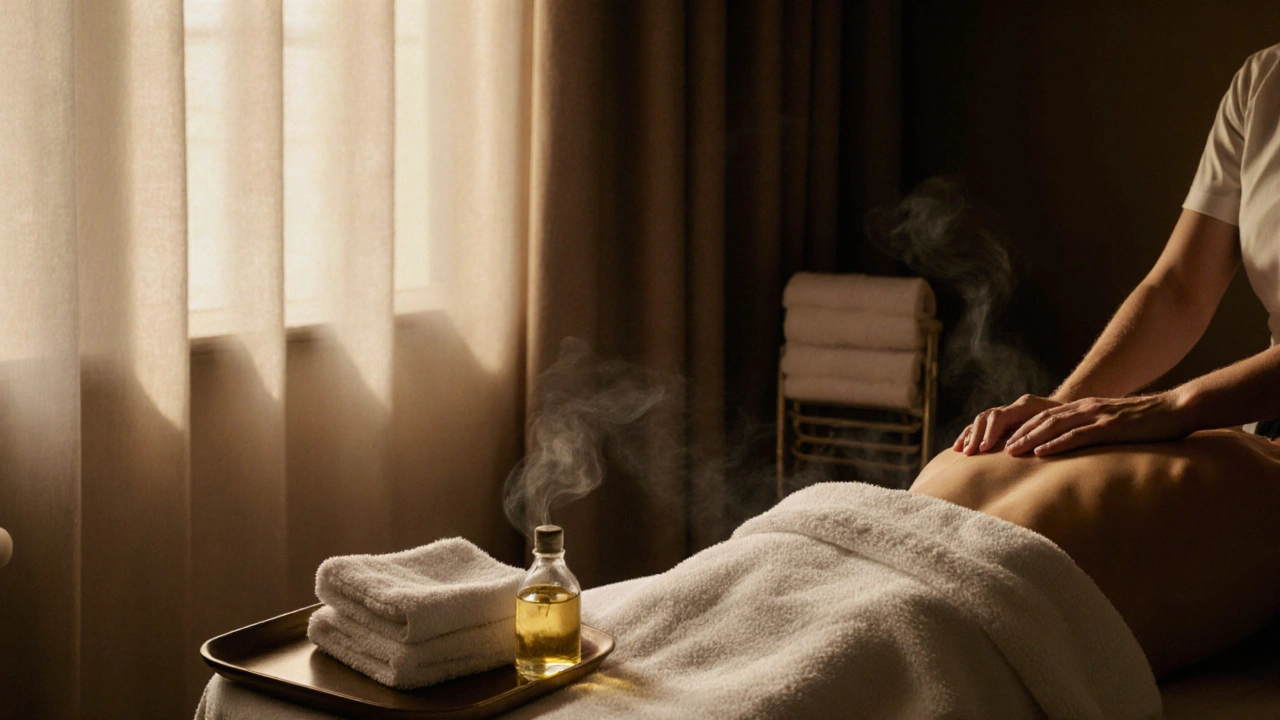Body Massage: A Natural Solution for Migraines and Headaches

If you’ve ever been hit by a migraine or a pounding headache, you know how quickly it can take over your day. No amount of coffee, painkillers, or dark rooms seems to help. But what if the relief you’re looking for isn’t in a pill bottle-it’s in your hands, or more accurately, in the hands of someone trained to ease tension where it lives: your muscles?
Why Tension Builds in Your Neck and Shoulders
Most headaches don’t start in your head. They start in your neck, upper back, and shoulders. When you sit at a desk for hours, stare at a screen, or sleep in a weird position, your muscles tighten up. The trapezius, levator scapulae, and suboccipital muscles-tiny but powerful-get stuck in a constant state of contraction. That tension pulls on the nerves and blood vessels connected to your skull, triggering what doctors call tension-type headaches or even migraines in people who are sensitive to nerve irritation.A 2023 study in the Journal of Bodywork and Movement Therapies followed 120 people with chronic tension headaches over 12 weeks. Half got weekly body massage sessions focused on the neck, shoulders, and upper back. The other half didn’t. After three months, the massage group reported a 68% reduction in headache frequency and a 57% drop in pain intensity. No drugs. No side effects. Just hands working on tight spots.
How Body Massage Actually Stops Headaches
It’s not magic. It’s physiology. Here’s what happens when you get a body massage for headaches:- Relaxes overworked muscles: Massaging the trapezius and suboccipital muscles releases built-up lactic acid and calcium buildup that keeps them locked tight.
- Improves blood flow: Better circulation means more oxygen and nutrients reach the brain, helping it reset after stress or inflammation.
- Reduces cortisol: A single 60-minute massage can lower cortisol (the stress hormone) by up to 31%, according to research from the University of Miami. Less stress = fewer triggers for migraines.
- Calms the nervous system: Massage activates the parasympathetic nervous system-the part of your body that says, “It’s safe to relax now.” This directly counters the fight-or-flight state that often sparks headaches.
People who get regular body massages for headaches don’t just feel better during the session. They start sleeping better, feeling less anxious, and noticing their headaches are less severe when they do happen.
What Type of Body Massage Works Best?
Not all massages are created equal when it comes to headaches. You need targeted pressure, not just a relaxing rubdown.- Swedish massage: Good for beginners. Uses long, flowing strokes to ease overall tension. Helps if your headaches are stress-related and you’re new to massage.
- Deep tissue massage: Best for chronic cases. Focuses on the deeper layers of muscle in the neck and upper back. Can feel intense but delivers real results for people who’ve had headaches for years.
- Trigger point therapy: The most effective for migraine sufferers. The therapist finds specific knots (trigger points) in your neck and shoulders that refer pain to your head. Pressing on these points for 30-60 seconds can shut down the pain signal entirely.
- Myofascial release: Works on the connective tissue (fascia) that wraps around muscles. Tight fascia can pull on nerves and cause referred pain to the head. This technique gently stretches and releases that tissue.
Most people see improvement after just two to three sessions. But for lasting results, aim for once a week for a month, then every two weeks. Think of it like brushing your teeth-maintenance keeps the problem from coming back.

What to Expect During Your First Session
You don’t need to do anything special. Just show up. The therapist will ask where you feel the most tension. Most will start with your back and shoulders, then move to your neck and scalp if needed.Don’t be surprised if they press on a spot and you say, “That’s exactly where my headache hurts!” That’s the trigger point. They’ll hold it until the muscle softens-sometimes it takes a minute. It might sting a little, but it shouldn’t hurt. If it does, speak up.
After the session, you might feel a little sore, like after a good workout. Drink water. Rest. Avoid screens for an hour. Many people report feeling lighter, calmer, and surprisingly headache-free within 20 minutes of getting up.
What Doesn’t Work
Not every massage will help. Avoid these pitfalls:- Too light: A gentle spa massage won’t reach the deep muscles causing your pain. You need pressure that goes beyond the surface.
- Only focusing on the head: Head massages alone won’t fix neck tension. The root is usually lower down.
- Skipping consistency: One session won’t undo years of poor posture. Regular care is key.
- Choosing untrained therapists: Look for someone certified in neuromuscular therapy, trigger point therapy, or clinical massage. Ask about their experience with headache patients.
Can You Do It Yourself?
Yes-but with limits. Self-massage helps between professional sessions.Try this simple routine:
- Use your fingers to press firmly into the base of your skull, just behind your ears. Hold for 30 seconds. You’ll feel a knot there-press until it softens.
- Roll a tennis ball against the wall and lean into it, targeting the top of your shoulders. Roll slowly for 1-2 minutes per side.
- Place your hands on your upper back, thumbs pointing down. Press and slide your thumbs up toward your neck. Repeat 5 times.
Do this daily for 5-10 minutes. It won’t replace professional care, but it keeps tension from building up between visits.

When to See a Doctor
Massage is powerful-but not a cure-all. See a doctor if:- Your headaches come with vision changes, numbness, or vomiting
- You have a sudden, severe headache unlike anything before
- They wake you up at night
- They started after a head injury
These could signal something more serious. Massage works best as a complement-not a replacement-for medical care.
Real People, Real Results
Sarah, 39, worked as a graphic designer and got migraines 3-4 times a week. She tried everything: biofeedback, acupuncture, prescription meds. Nothing stuck. Then she started weekly deep tissue massage focused on her neck and upper back. After six weeks, her migraines dropped to once a month. “I didn’t realize how much tension I was holding in my shoulders,” she said. “Now I don’t even reach for ibuprofen unless it’s really bad.”Mark, 52, had tension headaches for 15 years. He thought it was just “aging.” After three months of biweekly sessions, he cut his headache days from 20 to 4 per month. “I sleep better. I’m not snapping at my kids. It’s like I got my life back.”
Final Thought: It’s Not Just About Pain
Body massage for headaches isn’t just a treatment-it’s a reset. It teaches your body that it doesn’t have to stay in survival mode. When your muscles relax, your mind follows. You breathe deeper. You think clearer. You stop bracing against the world.If you’re tired of living in the shadow of a headache, give body massage a real try. Not as a last resort. Not as a luxury. As a necessary part of your health routine-like drinking water or moving your body. Your head will thank you.
Can body massage really help with migraines, or is it just placebo?
Yes, body massage has been shown in multiple clinical studies to reduce migraine frequency and intensity. A 2023 study in the Journal of Bodywork and Movement Therapies found a 68% reduction in headache frequency among participants who received weekly massage focused on the neck and shoulders. The effects are linked to measurable changes in muscle tension, cortisol levels, and blood flow-not just perceived relief.
How often should I get a massage for headaches?
Start with once a week for four weeks to break the cycle of tension. After that, most people switch to every two weeks for maintenance. If your headaches are mild and infrequent, once a month may be enough. The key is consistency-your muscles remember tension, and regular massage helps them forget.
Should I get a head massage or a full body massage?
For migraines and tension headaches, focus on the body-especially the neck, shoulders, and upper back. Head massages alone rarely help because the source of the pain is usually lower down. A full-body session that includes trigger point work on the trapezius and suboccipital muscles is far more effective than just rubbing your temples.
Is deep tissue massage safe if I have migraines?
Yes, but communication is key. Deep tissue massage can be intense, and some people with migraines are sensitive to pressure. Let your therapist know about your condition. They can adjust pressure and avoid overstimulating sensitive areas. Many find that deep tissue work actually reduces their headache severity over time by releasing the root tension.
Can I use a massage gun instead of seeing a therapist?
A massage gun can help with mild tension between sessions, but it can’t replace a trained therapist. Professionals know how to locate trigger points, read muscle response, and adjust pressure in real time. Massage guns apply uniform force and can overstimulate nerves if used incorrectly. Use them as a supplement, not a substitute.
What should I avoid after a massage for headaches?
Avoid screens, loud environments, and stressful tasks for at least an hour after your session. Your nervous system is in reset mode. Drinking water helps flush out metabolic waste released during the massage. Avoid caffeine and alcohol right after-both can trigger headaches in sensitive people.




Natasha Malundu
November 12, 2025 AT 00:50So let me get this straight we’re just supposed to believe some massage therapist can fix what medicine couldn’t because their hands are magic now
My grandma used to rub my back with Vicks and I didn’t turn into a zen master
This feels like wellness cult propaganda dressed up as science
Tyler Crimp
November 13, 2025 AT 16:36I’ve been getting monthly deep tissue for my neck pain for over a year now and honestly it’s been life changing
I used to wake up with headaches 5 days a week
Now it’s maybe once a month if I’ve been hunched over my laptop all weekend
It’s not a cure but it’s way better than popping pills every other day
Also the sleep improvement was a surprise bonus
Madison Horst
November 14, 2025 AT 04:11Yessss this is so true!! I’ve been doing the tennis ball thing against the wall every morning and my shoulders dont feel like they’re made of concrete anymore
Also I started drinking more water after sessions and wow the brain fog just lifted
Therapist said my trapezius was basically a brick
Now I feel like a human again not a stressed out robot
Frank Naessens
November 15, 2025 AT 03:56Anyone else notice how every article about this has the same 2023 study cited like it’s the only one that exists
Also why is everyone acting like massage is some new miracle when we’ve known for decades that tension headaches come from tight muscles
It’s not rocket science just basic anatomy
Also why do they always say ‘no side effects’ when deep tissue can leave you bruised for days
Patricia Estera Esquejo
November 16, 2025 AT 22:04I’m so tired of people treating massage like it’s a spiritual awakening when it’s just physical therapy with better branding
My sister spent $800 on monthly sessions and still got migraines
She’s now on topiramate and hasn’t had one in six months
Don’t let influencers sell you snake oil while real medicine sits right there
Massage is nice but it’s not a replacement for diagnosis
Clay Hamilton
November 18, 2025 AT 05:49Look I get it you want to feel like you’re doing something holistic instead of just taking a pill but let’s be real here
If massage was that effective why are there still millions of people on migraine meds
Also why does every single one of these articles sound like a spa ad
And don’t even get me started on trigger points
That’s just a fancy way of saying ‘we press on your sore spot until you say oww’
It’s not science it’s placebo with elbow grease
And why do people act like they discovered this in 2023
My grandpa had a massage chair in the 80s
Paul Eric
November 19, 2025 AT 03:28I tried massage once
Therapist pressed on my neck and it hurt so bad I almost cried
Then I got a headache the next day
So now I just take ibuprofen and call it a day
Why make it complicated
My back hurts because I sit too much
My head hurts because I’m stressed
Just fix the cause not the symptom
donna maukonen
November 20, 2025 AT 00:50Just wanted to say thank you for this post
I’ve been doing the tennis ball thing for two weeks and honestly I’m crying happy tears
I didn’t know how much tension I was carrying until I let it go
Also I started sleeping on my back and it helped even more
It’s not magic but it’s real
And I feel like I’m finally listening to my body instead of ignoring it
🙂
Kristine Daub
November 21, 2025 AT 05:32As a physical therapist, I want to validate what’s here while adding nuance
Yes, massage is effective for tension-type headaches - and the 2023 study is solid
But consistency matters more than intensity
One deep session won’t undo years of poor posture
Self-care like the tennis ball technique, ergonomic adjustments, and hydration are equally important
And yes, avoid untrained providers - look for credentials in neuromuscular or clinical massage
This isn’t alternative medicine - it’s evidence-based somatic care
Just don’t let it replace medical evaluation for red-flag symptoms
And please stop calling it ‘wellness’ - it’s healthcare